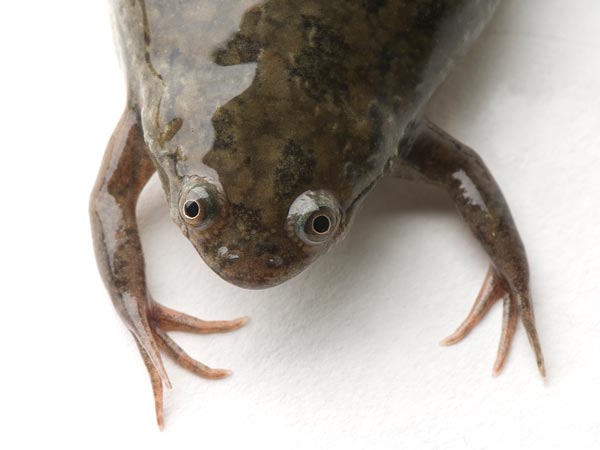African Clawed Frog Spreads Deadly Amphibian Fungus
Apocalyptic, catastrophic, devastating: All words used to describe chytrid fungus infections that are wiping out amphibians around the world, including hundreds of frog and salamander species.
“It did a really huge number on an entire genus of frogs in Central America,” said Marm Kilpatrick, a disease ecologist at the University of California, Santa Cruz (UCSC). The fungus probably caused several species of this harlequin frog (Atelopus) to go extinct, he added.
Chytrid is also largely responsible for endangering California’s mountain yellow-legged frog (Rana muscosa).
"It's the single biggest threat to vertebrate diversity in the world," Kilpatrick said.
The fungus, which seems to attack only amphibians, causes a thickening of the infected amphibian’s skin, preventing the animal from breathing properly and interfering with its electrolyte balance. The infection can eventually lead to cardiac arrest, although some frog species are better able to cope with it than others.
A new study delving into how this fungus spreads has now linked chytrid outbreaks in California—one of the more recent areas experiencing huge amphibian die-offs—to the spread of the African clawed frog (Xenopus laevis).
And the study’s implications could extend far beyond California, providing scientists with a potential road map showing how a devastating infection continues to spread around the world.
Until now, direct evidence of the chytrid fungus in African clawed frogs in regions of the world that have seen big amphibian die-offs has been missing, write the authors of the new study.
"I was surprised that nobody did this study before us, actually," said Vance Vredenburg, a conservation biologist at San Francisco State University and lead author of the new study, published May 15 in the journal PLoS ONE.
That could be because labs like his have been in crisis mode, scrambling to find a way to combat the fungus and save as many amphibians as possible, rather than trying to parse chytrid’s origins.
An African clawed frog, Xenopus laevis.
A Questionable Path
Chytrid's origins and how it spread have long been a big unanswered question for researchers, said Kilpatrick, who was not involved in the study.
Researchers in South Africa first proposed in 2004 that the African clawed frog was responsible for the spread of chytrid fungus around the world, said Vredenburg.
That earlier study suggested that the spread of chytrid was aided by the pet trade in African clawed frogs and by the animal’s widespread use as a research animal. Until the 1970s, the frog was also used in many hospitals as an indicator of human pregnancy; injecting the urine of a pregnant woman into the frog caused it to lay eggs.
Individual frogs that escaped or were released into the wild by hospital workers or pet owners may have carried the chytrid fungus, introducing the pathogen to new habitats around the world.
New Techniques
But a new technique developed by Vredenburg in 2011 allowed researchers to quickly evaluate whether amphibians, preserved as museum specimens, had the chytrid fungus or not.
Scientists could quickly swab the skin of an amphibian, analyze any DNA they picked up, and determine whether the chytrid fungus had infected the animal.
In what Vredenburg called the “old-school” way of testing for the fungus, analysis of a single tadpole required students in his lab to examine 200 skin samples under a microscope.
The new technique enabled Vredenburg’s research team to test 201 preserved frogs in the genus that includes the African clawed frog, collected from Africa and California between 1871 and 2010. The specimens, housed at the California Academy of Sciences in San Francisco, were all caught in the wild.
The researchers confirmed that wild specimens of the African clawed frog did indeed carry the chytrid fungus, yielding direct evidence of infection in this species outside of Africa.
That confirmation, combined with correlations between recorded instances of African clawed frogs around California and outbreaks of chytrid fungal infections, brings researchers one step closer to figuring out how this deadly infection became a global scourge.
Blame Game
But the blame for chyrid’s spread might not fall squarely on the African clawed frog, Kilpatrick cautioned.
The American bullfrog (Rana catesbeiana) is a popular source of frog legs served in restaurants around the world. And their movements can also be correlated to the spread of the chytrid fungus.
"The trade or movement of those two species has been responsible for the spread of [chytrid]," Kilpatrick said.
This pathogen could also have been present around the world in a nonlethal form, said Anna Savage, an evolutionary geneticist with the Smithsonian Conservation Biology Institute, who was not involved in the study.
Perhaps something in the environment changed, so that amphibians were no longer able to withstand the chytrid fungus, explained Savage, a former National Geographic grantee.
We’re still trying to compile basic information on this pathogen and how hosts, such as frogs, respond to it, she said. “So just knowing where it came from and how it spread, that’s really important information in terms of management strategies in dealing with this.”
Vredenburg is currently working on building a living library of beneficial bacteria that could help amphibians around the world combat chytrid infections.
His team is working to isolate bacteria native to amphibian populations that help some species resist chytrid. They're hoping to culture those beneficial bacteria and dose any infected populations, giving their systems a boost to help fight off the fungus.
"I'm desperate," Vredenburg said. "I don't want to see any more massive die-offs of frogs. I'm done with that."(Jane J. Lee,National Geographic,Published May 15, 2013)












